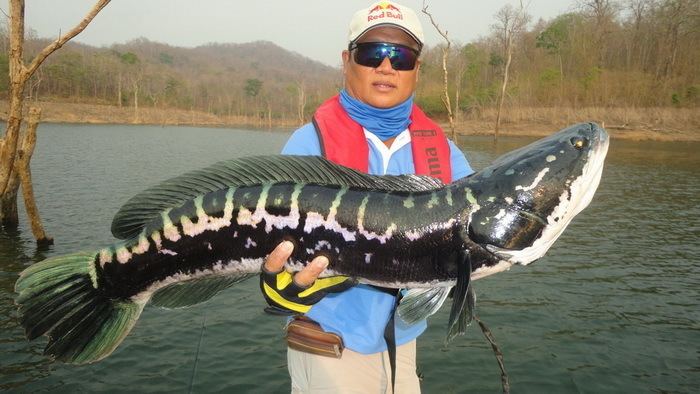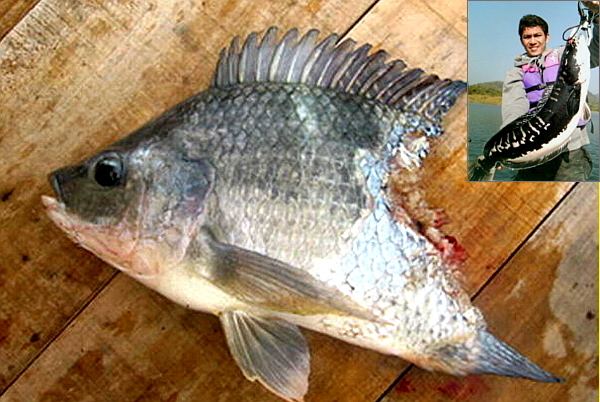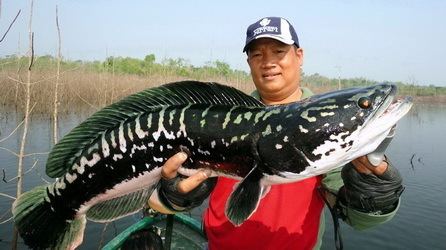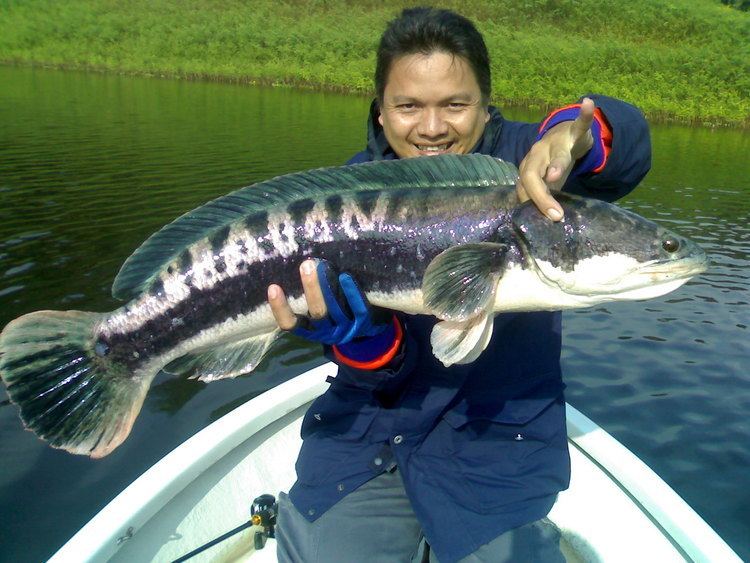Found in Tonlé Sap | Order Perciformes Genus Channa Higher classification Channa Rank Species | |
 | ||
Similar Snakehead murrel, Snakehead, Channa, Hampala, Blotched snakehead | ||
20ibs 9kg monster mama toman giant snakehead wild fishing thailand by bkkguy
The giant snakehead or giant mudfish (Channa micropeltes) is among the largest species in the family Channidae, capable of growing to 1.3 m (4.3 ft) in length and a weight of 20 kg (44 lb). It is native to the fresh waters of Southeast Asia (south Indian populations are now regarded as a separate species, C. diplogramma), but has also been introduced elsewhere, including the United States where considered invasive. Other names include xaal (শাল মাছ) in Assam, red snakehead, redline snakehead, and ikan toman (where ikan is "fish" in both Indonesian and Malay). The giant snakehead is known in Thai language as pla chado (Thai: ปลาชะโด).
Contents
- 20ibs 9kg monster mama toman giant snakehead wild fishing thailand by bkkguy
- Giant snakehead fishing in 2014
- Biology
- Use as food
- In the aquarium
- Distribution
- As an invasive species
- Hoax
- References

Giant snakehead fishing in 2014
Biology

The young of the giant snakehead are red in color, with orange and black lateral stripes appearing after about two months. As the giant snakehead matures, it loses its stripes and redness, and instead develops a bluish-black and white pattern on its upper body. Juveniles sold in the aquarium fish trade are commonly called "red snakeheads". They can get up to 1.3 m (4.3 ft) long and a weigh 20 kg (44 lb).

The species has the ability to crawl onto land and breathe air, although they are only able to do this in muddy or swampy areas, hence the nickname "mudfish".

Its ability to breathe air using a primitive lung located just behind the gills allows it to survive in stagnant water where oxygen levels are low, by coming to the surface and taking a small gulp of air. It also enables the snakehead to travel short distances on land, although it is unable to hunt while on land, as it cannot support itself at all with its small fins in comparison to its large body.
Use as food

In Malaysia and Singapore, they are known locally as the toman, while in Indonesia they are called gabus or haruan (not to be confused with another species of smaller snakehead known as the common snakehead also called haruan), and are cultured in fish ponds and reservoirs as game fish because they put up a strong fight when hooked. The giant snakehead is also a good fish to eat, and is often served in Chinese restaurants.

In Thailand, this fish is prepared in a variety of ways, especially grilled, being a common food item offered by street vendors. In the village/rural parts of Kerala[India], it has the reputation as a good food fish as it eats only live baits.[1]
In various Asian cultures, eating this fish is believed to help in healing of the body, for example, after surgery or severe cuts and scrapes.
In the aquarium
The giant snakehead, normally called red or redline snakeheads, are a popular fish to be sold in the pet trade. They are commonly sold as juveniles as pets. Some are even sold as feeders to be fed to larger carnivorous fish. They are voracious predators that will chase and eat anything that fits in their mouths. Due to this, they are called "freshwater great whites". However, they can successfully be housed with silver arowanas, clown knife fishes, oscars, and other fish from same size group.
Distribution
The giant snakehead is found in Southeast Asia, including the Mekong and Chao Phraya River basins in Cambodia, Laos, Thailand and Vietnam, as well as the Thai-Malay Peninsula and the islands of Borneo and Sumatra in Indonesia. It used to be believed to have an oddly disjunctive distribution, inhabiting both Southeast Asia and southwest India, about 2,500 km (1,600 mi) apart. The Indian population was speculated to be from an early human introduction, prior to the 19th century. In 2011 it was established that the southeast Asian and Indian population are separate species, with the latter correctly named C. diplogramma (leaving C. micropeltes for the southeast Asian population).
Ebanasar (1995) has also conducted series of experiments on the biology, physiology and culture of this fish. This fish is reported to be highly suitable for cage culture and culture in ponds in combination with tilapia. It is found to be an effective tool in controlling the overpopulation of tilapia and thus checks the stunted growth of tilapia.
As the result of human introductions, the giant snakehead has been reported already in six US states, including Wisconsin, Maryland, and parts of Virginia.
As an invasive species
In 2002 and 2003, three specimens were caught in Maryland, USA, all believed to have been released pets. In 2003, a giant snakehead was caught in Rock River, Wisconsin. Biologists were concerned that warmwater effluents could allow the tropical species to survive in the colder climate.
In 2010, a giant snakehead was found dead on the shores of the St. Charles River, in Quebec City, Canada. It was obviously an aquarium release.
Hoax
In 2008, a specimen of C. micropeltes was reportedly caught by an angler while fishing for pike on the River Witham in Lincolnshire, England. The claim of this catch is highly peculiar, as it was reportedly caught in late winter, and, being a tropical species, it would not have been able to survive, let alone feed in an English river during winter. A source within the Environment Agency was quoted as saying, “The reaction was, 'Oh s***'. This is the ultimate invasive species — if it starts breeding here it's a disaster." However, it was later determined to be a hoax; the fish had actually been found dead in a street.
